This is how Man United can beat Man City and win the FA Cup - ESPN
Ryan O'Hanlon, ESPN.com writerMay 24, 2024, 09:53 PM
Close
Ryan O'Hanlon is a staff writer for ESPN.com. He's also the author of "Net Gains: Inside the Beautiful Game's Analytics Revolution."Manchester City: probably going to beat Manchester United on Saturday!

For the FA Cup final (Saturday, 9 a.m. ET on ESPN+), Man City are a minus-700 favorite to win the tournament for the second year in a row, per ESPN Bet. You'd have to bet $700 on City just to win $100. When you take Man United's odds into account (plus-300) and then remove the vig (essentially the fee the sportsbook charges you in order to make a bet), it comes out to an 83% chance that City lift the trophy and a 17% chance that United pull the upset.
For comparison: in the Champions League final -- between the dominant Champions League team of all time and the fifth-place team in the Bundesliga -- Real Madrid are 73% favorites, with Dortmund garnering a 27% chance of taking home their second European Cup. These were roughly the same odds when City and United met in last year's FA Cup final.
Manchester City brought in €826 million of reported revenue last year, per Deloitte, and Manchester United brought in €746 million -- but despite the relatively similar financial strength, the FA Cup final is a true David-vs.-Goliath situation on the field.
• Watch live on ESPN+: Man City vs. Man United (FA Cup final)
It's very unlikely that Man United will win on Saturday, but it's not impossible. Play this match 10 times and United would probably win once, maybe twice. Such is the nature of a low-scoring sport with a bouncing ball that outlaws the use of your hands.
So, if we were to get that 1-in-10 or 2-in-10 outcome on Saturday, what might it look like? Here are five ways Manchester United could actually beat Manchester City and win the FA Cup.
1. Erling Haaland can't find the back of the netFinishing is a funny thing.
In Erling Haaland's first Premier League season, he attempted 123 shots worth 28.9 expected goals. In his second Premier League season, he attempted 121 shots worth 29.4 expected goals. In 2022-23, 60 of those shots ended up on target. In 2023-24, 59 were on target. Across both campaigns, Haaland hit the target with 48.8% of his shots.
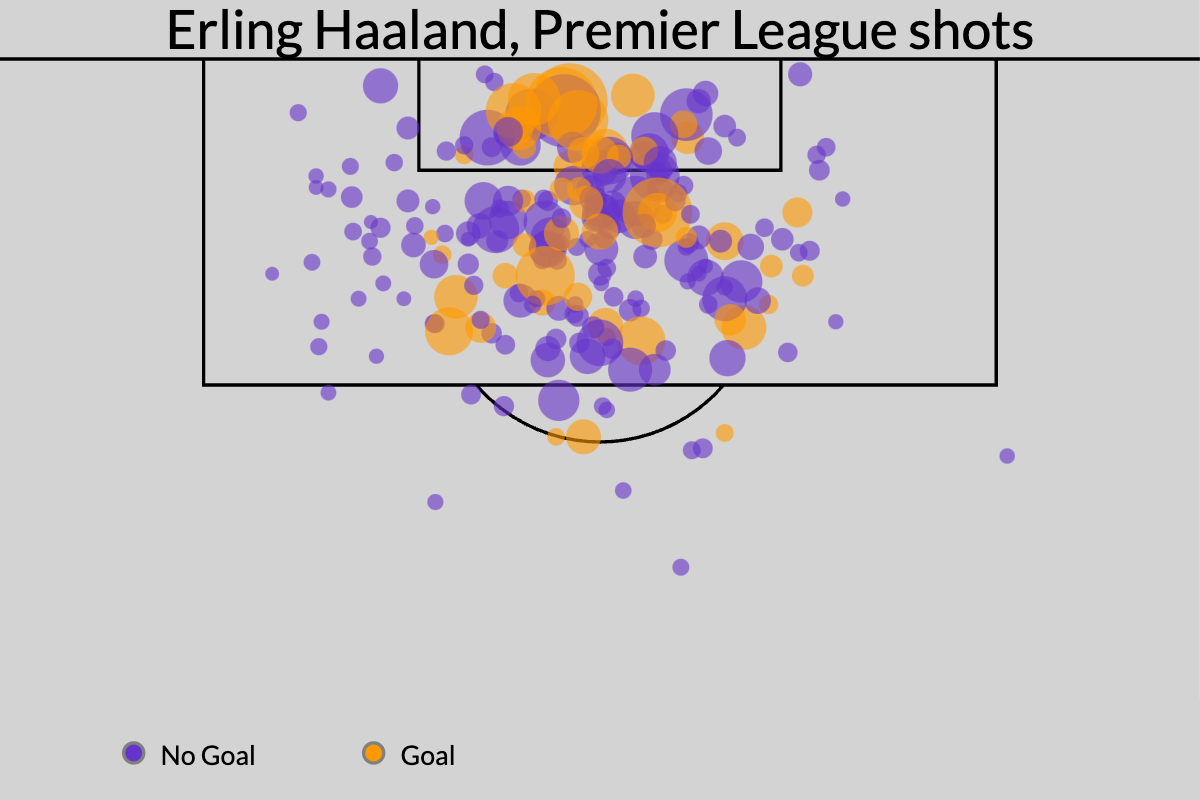
The big difference: 36 of those shots turned into goals last season, while 27 found the back of the net this season. As far as we're able to measure these things, the only real difference between this season and last season is what happened once the ball left Haaland's foot or head. If you trained a robot striker on the virtues of shot selection, it would produce a shot map that looks pretty much exactly like this -- attempts are sized by the xG value, or expected goals value, of the shot:
If there's one difference from this season to last, it's that Haaland is taking a bigger chunk of his shots with his head: 23% last season, up to 26% this season. Headers are less likely to turn into goals because the ball is in the air and they're almost always first-time attempts. The xG models know this, but Haaland, despite his size, has never been a truly dominant header of the ball, so perhaps that has dragged his efficiency in front of goal down slightly.
Haaland's first two seasons, though, provide a succinct summary of everything we know about scoring goals. Most of it comes from your ability to consistently get on the end of great chances -- and that's the most repeatable, year-on-year skill. Haaland's consistency in that regard is frightening, particularly if you're Man United on Saturday.
Finishing, though, is harder to predict, and it accounts for a smaller chunk of a player's goal scoring. On a nearly identical shot profile, Haaland exceeded his xG by about seven goals last season and then trailed his xG by about two goals this season. An individual player, then, can experience something like a 10-goal finishing swing from season to season on a consistent diet of shots. But when that player is as good as Haaland is at finding space inside the box, that swing won't even be enough to prevent him from winning the Golden Boot in consecutive seasons.
For a little while there, it didn't seem like Haaland was human. He'd smashed his xG totals in his three years at Dortmund and his first year with City. This season, though, proved that he's just as prone to fluctuations in finishing as anyone else.
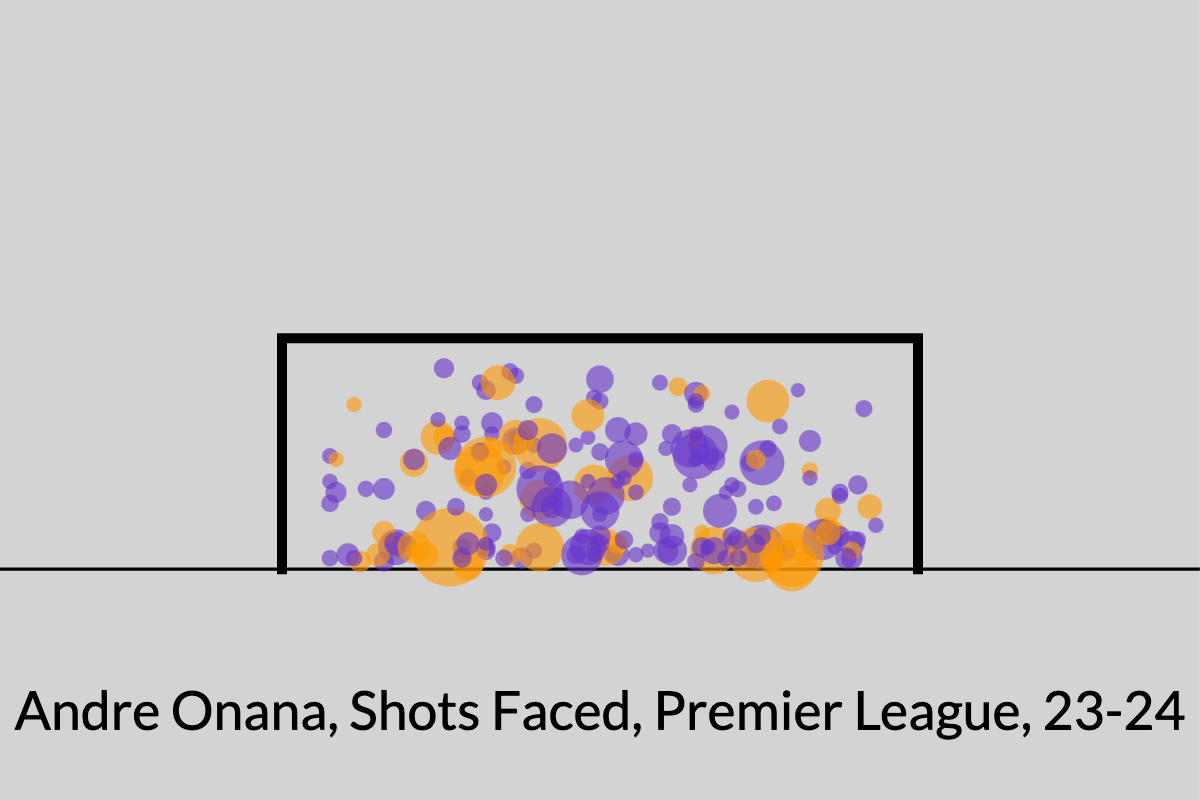
Haaland has had seven games this season where he generated shots worth at least 0.7 xG and turned none of them into goals. If you could guarantee that this would happen again on Saturday, United's odds of winning would be way higher than 13%.
2. André Onana stands on his headThere are very few worlds where Man United don't get buried under an avalanche of shot attempts. And most of the worlds where they don't are worlds where Man City go up a couple of goals early and then squeeze the life out of the match. And so, if United are to prevail, they'll likely have to find a way to dodge raindrops for 90 or even 120 minutes.
In the Premier League this season, Man United allowed 660 shots -- more than every team in the league outside of Sheffield United, who conceded a Premier League-record 104 goals. Flip it around, and only two teams in the Premier League even attempted more shots than Man United allowed: Liverpool's 781 and Man City's 683.
Put another way, United allowed more shots this season than second-place Arsenal even attempted in the same number of games. United's opponents, on average, created more chances than the team that finished second and scored 91 goals. Add in that they're playing City on Saturday -- and not, say, Brighton or Crystal Palace -- and there will be lots of shots.
When you concede a lot of shots, you do give your goalkeeper an opportunity to make a lot of saves, and although he has had some high-profile errors this year, André Onana has frequently been lights out behind United's truly awful defense. Among all keepers in Europe's "Big Five" top leagues this season, per the site FBref, Onana is tied for the lead with most matches (16) where he conceded at least 0.5 goals fewer than expected, based on where each attempt came from and where it ended up on the goal frame.
Over the season, Onana conceded 2.2 goals fewer than expected -- the fifth-best mark in the league. Orange are goals, and the bigger the circle, the higher the post-shot xG value of the attempt:
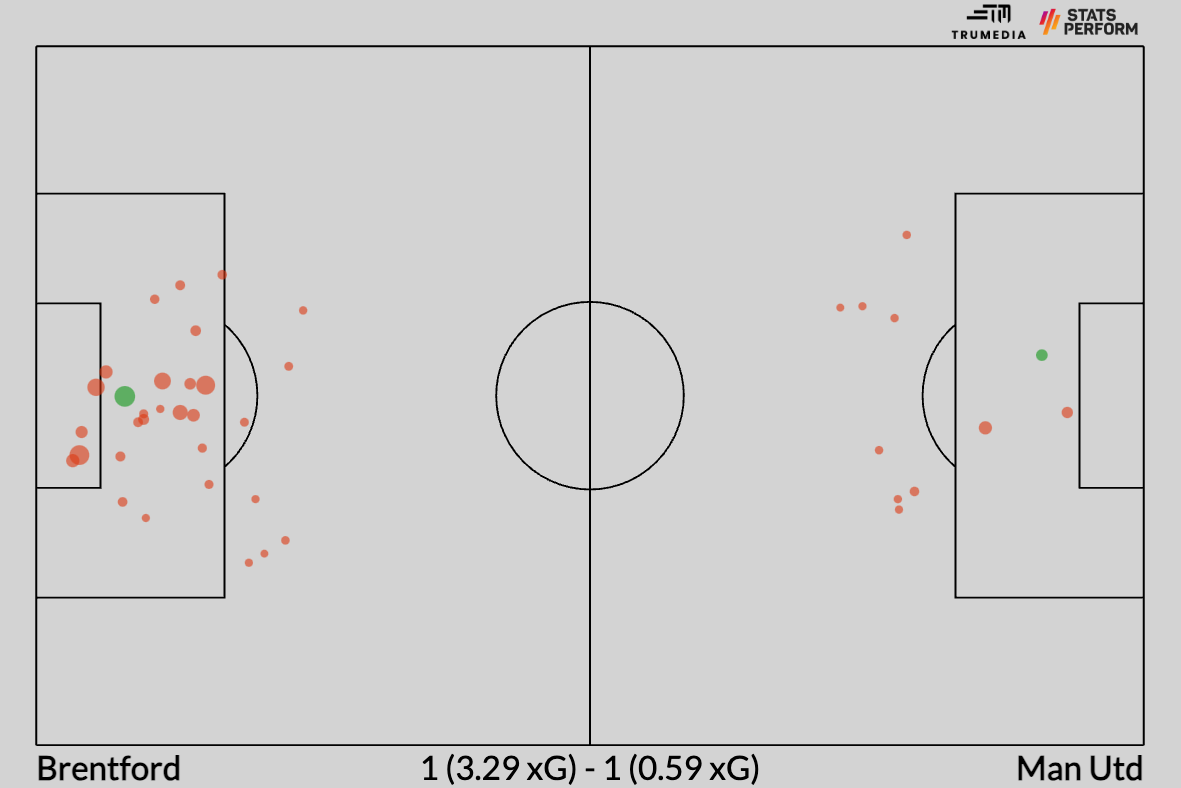
What you can read from this is that Onana's big strength is smothering central attempts where there aren't many defenders in front of the ball. He's not tipping wide those shots bound for the upper corners -- he's making himself big and stopping shots from the center of the box. Also known as: the exact kind of shots that City like to create.
Having so many positive shot-stopping performances, but grading out only a couple goals above average speaks to Onana's volatility from match to match. He also has had 12 games where he allowed at least 0.5 more goals than expected -- only seven goalkeepers had more games like that across the Big Five leagues. One day he's saving everything, and the next a bouncing mishit sneaks through his legs.
If United win on Saturday, there's a good chance Onana ends up winning man of the match.
3. Manchester City can't control the boxesWe know that Manchester City will control the ball on Saturday, and we know that they'll probably pin it deep into Manchester United's defensive third. This happens in almost every game that Man City play under manager Pep Guardiola no matter the result. However, in City's four losses across all competitions this season, they've averaged 24 touches in the opposition penalty area while conceding 21 inside their own box. In wins and draws, they've averaged 43 touches in the opposition penalty area and conceded 14.
Of course, more touches in the opposition box (and fewer allowed in yours) correlate pretty highly with winning games, but I'm not sure it's as obvious as it might seem with City. In their losses, you'd picture them pushing their opponent all the way to the end line and then getting done in by the occasional counter. But their losses this season have come from an inability to break the 18-yard box and continued pressure from their opponents running into their penalty area.
This is the new version of City, where the fullbacks aren't really attackers, there is frequently not a single winger on the field, Haaland isn't aiding buildup play, and there's no midfielder running into the box. When it doesn't work, they simply are unable to work the ball close to the goal, and the opposition is able to get up a head of steam and still break past the increased defenders that they frequently keep behind the ball.
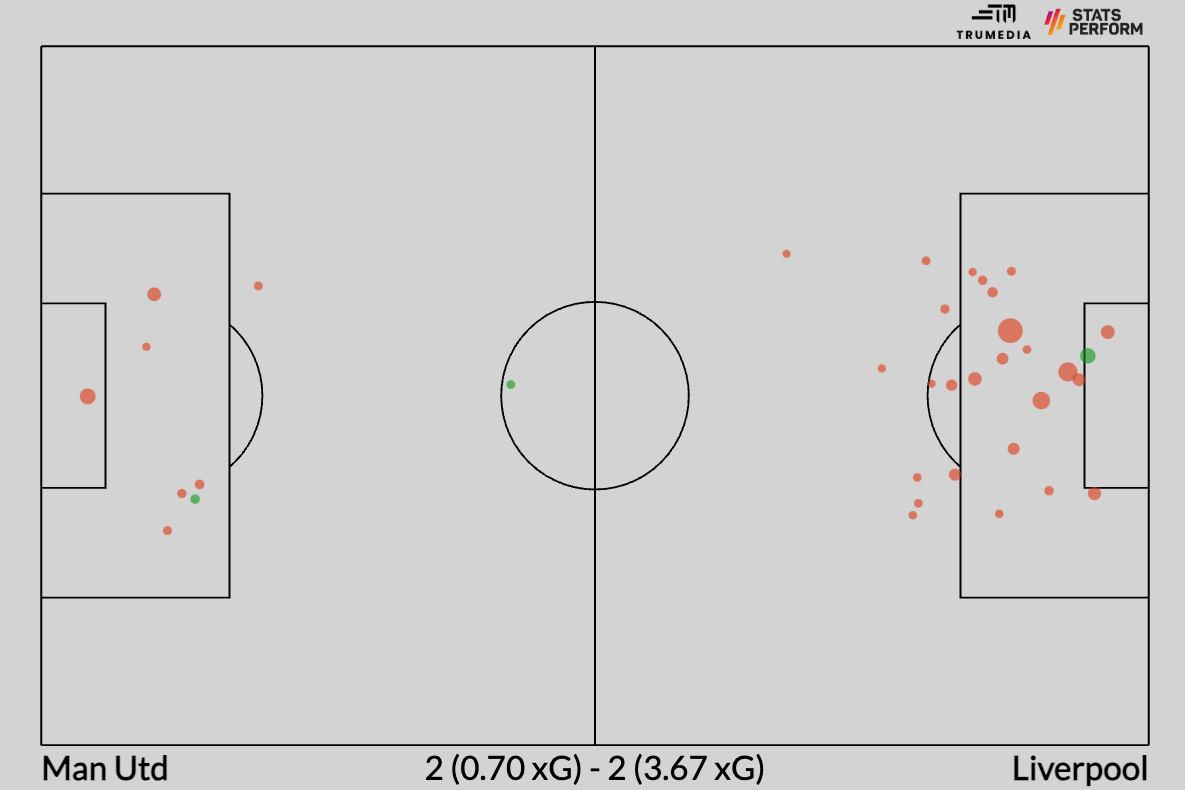
United haven't shown any kind of efficiency in this regard. They average slightly more possession than their opponents and slightly more final-third possession than their opponents, but they've allowed way more shots than they've taken this season and they've allowed more touches inside their box than they're taken inside the opposition penalty area. They've also allowed more goals (5) from counterattacks than they've scored (3).
Last season, though, they led the league with nine goals from counters. If they're going to score on Saturday, they'll need to recapture some of that open-field magic.
4. Manchester United don't play terribly and then hope for the bestPer Opta's global power ratings, City (100) are the highest-rated team in the world, while United are 33rd, with a rating of 87.9. Across all competitions this season, teams with a rating of 93 or better have lost 19 times to a team with a rating somewhere between 83 and 89.
In these games, the underdog allowed, on average:
• 63% of final-third possession • 30 touches in the box • 15 shots • 1.6 xG
Compare that with the per-game averages for every team across the Big Five leagues this season:
• 50% of final-third possession • 24 touches in the box • 13 shots • 1.4 xG
In these same games, the underdog averaged:
• 37% of final-third possession • 23 touches in the box • 13 shots • 1.4 xG
So, these teams conceded more shots than average and allowed much more final-third possession but still found a way to generate an average number of shots, touches in the box, and xG. Over the 19 games, that led to a chance-creation deficit -- 25.8 xG for, 29.8 conceded -- but that at least put them in the realm where normal finishing fluctuation could decide the match. The underdogs turned those shots into 45 goals in these games, while the favorites scored just 17.
The issue for United in both of the Manchester derbies so far this season is that both matches got way out of hand across every phase of the game. City had 82% of the final-third possession, took 56 touches in the box per game and generated 3.7 xG per match. United, meanwhile, created a measly 0.6 xG from a measly 13 touches inside the box.
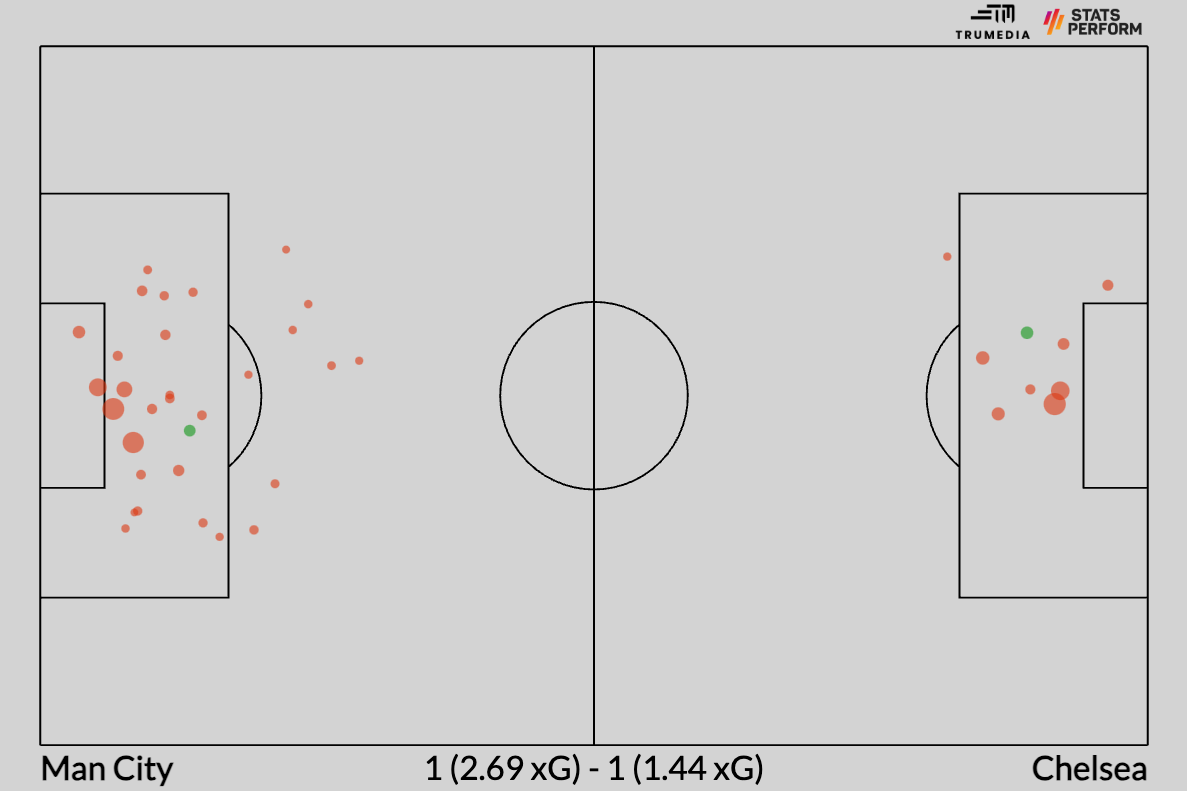
United were ineffective at limiting City in any way and ineffective in hurting them in any way. To at least give themselves a fighting chance as an underdog, United manager Erik ten Hag will have to commit to some kind of tailored strategy that will at least make it tough for City to press, or keep the ball, or create high-quality chances.
By attempting to limit one aspect, you're opening yourself up to getting dominated in another area, but when you're nearly a 90% underdog, there are always going to be trade-offs. The job of the manager is to figure out which is the right one. You can't just play how you always play.
5. PrayFrom eyeballing pregame betting lines, it seems like Manchester City are favored to win the game by around 1.75 to 2 goals. There's one obvious way for Manchester United to immediately erase a margin of that size, and it doesn't require much from any of United's players.
No, they just need the referee, Andrew Madley, to send off a City player right at the beginning of the game. Studies have found that a team playing with 10 men for an entire match should be expected to perform 1.45 goals worse than it does with 11 men. Over a full game, a red card costs a team 0.7 goals on the attacking end and 0.75 on the defensive end. That would come close to putting United on equal footing for the rest of the match.
Since 2008-09, there have been 12,610 Premier League matches -- and just one has featured a red card before the second minute of a match. So, there's a 1-in-12,610 chance that a player gets sent off before the second minute of Saturday's game. Funnily enough, the one time it happened was in February of 2021, when Southampton's Alexandre Jankewitz was red-carded against Manchester United, who went on to win the game 9-0.
Another path to victory might be through Jack Grealish. In some cultures, there's this concept of continuous stew: where you start with a stew and just continuously add new ingredients as you ladle some stew out to eat. These stews can sometimes be cooking for upward of 50 years. The England winger paid homage to this tradition by seemingly dosing his body with adult beverages for nearly the entire summer after Manchester City won the treble last year. Perhaps his teammates saw how much fun he had and have opted to do the same this past week after the club won a record fourth Premier League title in a row.
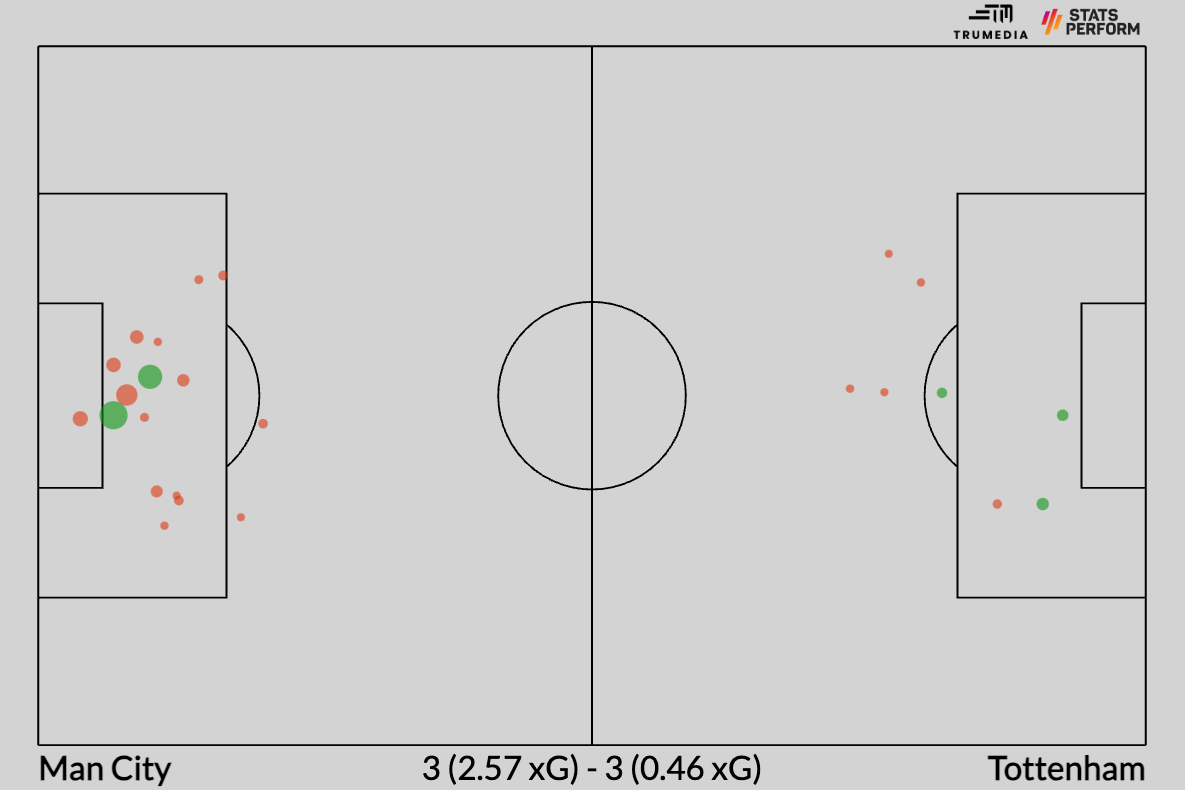
Barring that? You know, sometimes the worse team plays poorly and still wins the game. Since the start of last season, there have been 332 games where a team produced an xG differential of minus-1 or worse. Why set it at minus-1? Sheffield United, one of the worst Premier League teams of all time, finished with an expected goal differential of minus-1 per game this past season.
Anyway, across those 332 games, the worse team won 13 matches (4%) and managed a further 29 draws (9%). In fact, the two biggest xG deficits that didn't result in losses were both games United drew, this season, just eight days apart. The first was a 1-1 draw with Brentford:
And the second was the 2-2 tie with Liverpool:
Although they closed out the season with nine straight wins and it certainly seems like they never drop points they shouldn't, City drew 1-1 with Chelsea in a match they dominated back in February:
And same goes for the 3-3 tie with Tottenham in December of last year:
But why not take a step further? Back in November 2020, Arminia Bielefeld managed to push a 1-1 draw into the 88th minute against Bayer Leverkusen before Aleksandar Dragović scored a late winner. The game ended 2-1, and no one was in the stadium to see it happen, so in the grand scheme of European soccer, it might as well have not even happened.
But what makes this game so important is precisely that: the thing that never happened. Arminia literally did not attempt a single shot for the entire match but still managed to be tied with two minutes left in regulation, thanks to an own goal from Leverkusen's goalkeeper. If a team can score a goal without attempting a shot, then one day a team will win a game without attempting a shot.
Manchester United: will you accept this challenge? Your FA Cup hinges on it.









































